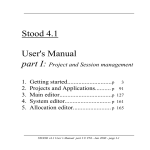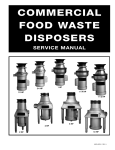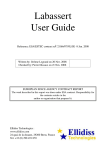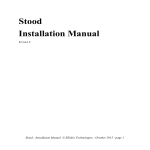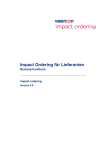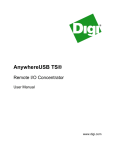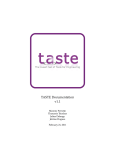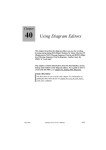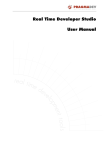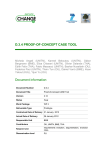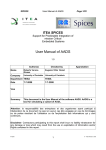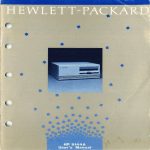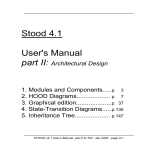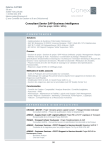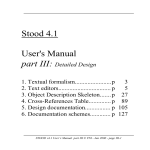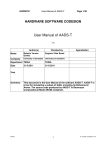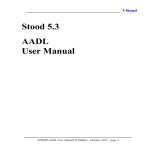Download STOOD-Admin Manual revD.cwk - the Ellidiss Technologies web site
Transcript
Ellidiss www.ellidiss.com Stood Administrator Manual revision D STOOD Administrator Manual © Ellidiss - October 2011 - page 1 Pierre Dissaux Pam Flood page 2 - STOOD Administrator Manual © Ellidiss - October 2011 This manual explains how to customize Stood. It is assumed here that a standard installation procedure for the product and its license server has been followed successfully before attempting to use Stood. Please refer to the Installation Manual in case of any problem. Stood v5.3 is available for both Unix/Motif and Windows platforms. 1 Administrator’s customizations.....p. 1.1 Binary files......................................... p 1.2 Configuration files..............................p 1.3 Application examples.........................p 1.4 Prolog engine......................................p 1.5 Unix interface (for Windows only).... p 5 5 8 48 49 67 2 User’s customizations................... p. 69 2.1 Properties............................................p 2.2 Changing applications search path.....p 2.3 Customizing target languages............ p 2.4 Customizing the main window...........p 2.5 Changing default fonts and colors..... p 2.6 Customizing the environment............ p 2.7 Other simple customizations.............. p 2.8 Configuration management................ p 2.9 Requirements management................ p 69 71 73 77 83 87 89 93 96 3 Launching Stood........................... p. 98 3.1 STShell............................................... p 3.2 Stood executing modes.......................p 99 107 STOOD Administrator Manual © Ellidiss - October 2011 - page 3 page 4 - STOOD Administrator Manual © Ellidiss - October 2011 1. Administrator’s customizations This chapter contains usefull information to check and customize the current installation of the product on your system. The following components should be found on the system after a proper installation of Stood v5.3: 1.1. Binary files 1.1.1. Supported platforms The bin.xxx directory contains all the required platform specific binary files, where xxx identifies the actual environment which should be one of the following: • sol2 for Solaris2 on Sun sparc platforms. • w32 for Windows on PC platforms. • pclinux for Linux/OpenMotif on PC platforms. Binaries for the other platforms may be available. Please contact ELLIDISS' technical support for further information: [email protected] STOOD Administrator Manual © Ellidiss - October 2011 - page 5 1.1.2. Executable files The available executable files for a given platform are listed below. On Windows platforms only, all executable files have a .exe extension after the filename: main executable to launch Stood prolog engine for post-processors Ada lexical analyser C lexical analyser C++ lexical analyser pseudo-code lexical analyser AADL Behavior Annex lexical analyser Ada syntactic analyser C syntactic analyser AADL v2 syntactic analyser stood sbprolog scan_ada scan_c scan_cpp scan_pseudo scan_aadl adarev crev aadlrev Note that some distributions of Stood may also encompass additional products, such as AADL Inspector which comes with various AADL analysis tools: Cheddar for schedulability analysis and Marzhin for real-time simulation. Use of Marzhin requires that a proper Java Runtime Environment is installed on the platform. 1.1.3. Ancillary files A few ancillary files need to be located inside the bin directory: stood.eng stood.bmp Stood localization file startup image page 6 - STOOD Administrator Manual © Ellidiss - October 2011 1.1.4. Initialization file The bin directory also contains a default initialization file where customizable options and parameters may be set to fit the user’s preferences: .stoodrc stood.ini default initialization file for Unix default initialization file for Windows Other copies of these files may be created and customized inside users working directories in order to manage several concurrent configurations. More details about initialization files contents and customization is provided in §2. If no other initialization file is found, Stood will use the one located inside the bin directory. The initialization file gathers all user level customizations. It is recommended not to modify the initialization file provided during a standard installation procedure of the product. However, customized initialization files may be created in the various working or home directories. These additional initialization files just need to contain the actually overloaded properties. All the other properties will be set to their default value, as defined in the bin directory. Many other customization capabilities are available at the administrator level. These other customizable features are located inside the config directory and will be listed later in this chapter. Note that recent Stood distributions come with two initialization files: stood_HOOD and stood_AADL. By default, the initialization file located in the bin directory is a copy of stood_AADL. STOOD Administrator Manual © Ellidiss - October 2011 - page 7 1.2. Configuration files The config directory is the general container for all the platform independant configuration files, including the documentation and code generators. Features contained in this directory may all be customized by the administrator of the tool. Many of these features operate like plugins, that may be added, modified or removed with a simple "plug and play" maintenance process. The standard configuration complies as far as possible with the HOOD Reference Manual (HRM) release 4.0, September 1995, and has been extended thanks to numerous feedbacks from operational users and projects. More recently, support of Hard Real Time extensions (HRT-HOOD) has been added to Stood, and other standards like the Architectural Analysis and Design Language (AADL) or the version 2.0 of the Unified Modeling Language (UML) are now supported in the last versions of the configuration. Several configuration directories may be defined in order to fit the specific requirements for a given Project. It is possible, for instance, to: • define and implement specific code generation, documentation and verification rules; • implement communication utilities with other tools; • customize help files; To switch from a given configuration directory to another, the ConfigPath property should be properly set within the relevant initialization file (stood.ini or .stoodrc). Refer to §2.6 for further details. For instance, the config_AADL directory provides a specialized configuration for AADL users. Features that are not re-defined in this directory are inherited from the default config directory. page 8 - STOOD Administrator Manual © Ellidiss - October 2011 1.2.1. Code generators The code generators are located inside the code_extractors configuration subdirectory. There is a dedicated subdirectory for each installed code generator: • • • • config/code_extractors/ada config/code_extractors/c config/code_extractors/cpp config/code_extractors/aadl Ada C C++ AADL Each of these subdirectories contains a set of files that are used by Stood each time the corresponding code generation action is invoked. The code generation rules are written in the prolog language. When starting code generation, Stood produces a prolog facts base and gives the control to a prolog engine which loads both facts and rules bases, to generate source code files (refer to §1.4). The contents of a code generation directory are shown below. Some of these files may be customized by the tool administrator. Extract.pro Extract.sbp Init.pro Init.sbp Input.sbp go.sh scan.lex special extractors pragma makefile prolog rules (source code) prolog rules (binary code) prolog run-time interface (source) prolog run-time interface (binary) input file for code extraction (rules base) launching shell script lexical analyser (lex code) definition of code-dependent symbol types definition of code extraction modes definition of code extraction options to re-build code extractor if required STOOD Administrator Manual © Ellidiss - October 2011 - page 9 More details about the content and use of these files is provided in the user manual. Like the other plugins, the code generators may be updated more frequently than the Stood kernel. To know the precise version of a code generator, edit the Extract.pro file, whose header provides the date of the last modifications. The file extractors is used to define different profiles for the code generation process (for instance, full or partial generation), and to specify the configuration variables that can be used to handle the source code suffix: SuffixSpecVariable "ADASPECSUFFIX" defines an initialization file property in the Languages category(cf. §2.3.2). ProcedureSpecVariable "$As" defines the corresponding pseudo variable for the DataBase file (cf. §1.2.9). While launching Stood, a set of verifications are performed on the configuration files. You must ensure that, when performing specific customizations, inconsistencies are not introduced. The main issues may come from differences between the DataBase file and the various configuration subdirectories it refers to. This is especially important for the code generators that can easily be removed or added to the configuration directory, whereas the DataBase file has not necessarily be properly updated. For instance, if the Ada code generator has been removed from the configuration directory, but some DataBase sections still refer to the Ada language, then the following warning will be shown at launch time: page 10 - STOOD Administrator Manual © Ellidiss - October 2011 1.2.2. Document generators The documentation generators are located inside the doc_extractors and the doc_templates configuration subdirectories. Documentation may be ones produced in various formats. There is a dedicated subdirectory for each installed document generator: • • • • • • config/doc_extractors/html config/doc_extractors/odt config/doc_extractors/mif config/doc_extractors/ps config/doc_extractors/rtf config/doc_extractors/pdf HTML file OpenOffice input file FrameMaker input file PostScript file MSWord input file PDF file Each of these subdirectories contains a set of files that are used by Stood each time the corresponding document generation is invoked. Document generators are written either in the prolog language (those whose directory contain a prolog file), or using the docBook technology (those whose directory contain a docbook file). Note that the easyDoc technology is no longer supported. Both kinds of generators may be customized by the tool administrator. The following files should appear in each document generator: variable.cfg suffix.cfg keepps.cfg definition of document variables definition of output file suffix specifies to keep temporary graphics (optional) STOOD Administrator Manual © Ellidiss - October 2011 - page 11 In addition to .cfg files, the prolog document generator directories contain: Extract.pro Extract.sbp Init.pro Init.sbp Input.sbp print.sh printer.sh preview.sh header.xxx prolog makefile gif prolog rules (source code) prolog rules (binary code) prolog run-time interface (source) prolog run-time interface (binary) input file for code extraction (rules base) main launching shell script additional script to send to a printer additional script to send to a pre-viewer initializations, tags definitions identifies a prolog generator to re-build doc generator if required insertion of GIF graphics Important notes: • The file printer.sh is used to send the produced document to a printer or a documentation tool. The tool administrator must customize this file with the actual name of the printer or print spooler to use. • The file header.xxx (where xxx may be ps, tps or mif), may be edited to change the fonts to be used in the documentation. • Other .sh files may be created to propose different printing modes or different printers to the user. When print.sh is the only one defined, only the file only entry is presented in the tools menu. When additional scripts are defined, corresponding entries are automatically presented in the tools menu. • The odt document generator contains an additional template subdirectory. page 12 - STOOD Administrator Manual © Ellidiss - October 2011 In addition to .cfg files, the docBook document generators uses the doc_templates subdirectory which contains a customizable template for each corresponding format. config/doc_templates/portrait.rtf config/doc_templates/portrait.style template for Word documents template for PDF documents These files may be edited to customize the layout of the documents that are generated by Stood for these formats. Some of the document generators can insert a pre-defined keyword or text in case of a missing file or an empty list. The corresponding text must be specified in the following configuration files: config/MissingFile config/EmptyList default text for missing file in documentation default text for empty list in documentation STOOD Administrator Manual © Ellidiss - October 2011 - page 13 1.2.3. Rules checkers The rules checkers are located inside the checkers configuration subdirectory. There is a dedicated subdirectory for each installed code rules checker: • • • • • config/checkers/hood config/checkers/metric config/checkers/requirements config/checkers/scheduling config/checkers/database design rules checker design metrics requirements coverage schedulability analysis design storage checker Note that the AADL checker is now replaced by AADL Inspector. Each of these subdirectories contains a set of files that are used by Stood each time the corresponding verification action is called. Rules checkers are written in the prolog language. When starting rules checking, Stood produces a prolog facts base and gives the control to a prolog engine which loads both facts and rules bases, to generate the appropriate check reports. The contents of a rules checker directory is shown below. Some of these files may be customized by the tool administrator. _Main.pro _Main.sbp _Init.pro _Init.sbp _Input.sbp go.sh makefile config prolog main rule (source code) prolog main rule (binary code) prolog run-time interface (source) prolog run-time interface (binary) input file for code extraction (rules base) launching shell script to re-build rules checker if required to specify the additional languages to process page 14 - STOOD Administrator Manual © Ellidiss - October 2011 These files are duplicated for each checker plugin, except for the database checker (see below). In addition to these files, a set of specific files are contained inside each checker subdirectory. The .pro suffix identifies the prolog source files and the .sbp suffix is used for the corresponding prolog binary files. Only the binary file is required in normal use. The source file is necessary to perform customizations to the default rules. The specific files for the design rules checker are: General.pro (.sbp) Include.pro (.sbp) Use.pro (.sbp) Operation.pro (.sbp) Provided.pro (.sbp) Visibility.pro (.sbp) Consistency.pro (.sbp) Required.pro (.sbp) Std.pro (.sbp) general design rules rules for Include relationships rules for Use relationships rules for Operations rules for Provided Interfaces visibility rules consistency rules rules for Required Interfaces additional rules for States &Transitions The specific files for the metric rules checker are: Cohesion.pro (.sbp) Coupling.pro (.sbp) Depth.pro (.sbp) Size.pro (.sbp) Other.pro (.sbp) cohesion of the design coupling between design entities depth of the design hierarchy size of the design entities miscellaneous metrics STOOD Administrator Manual © Ellidiss - October 2011 - page 15 The specific files for the requirements coverage checker are: Coverage.pro (.sbp) ERMatrix.pro (.sbp) REMatrix.pro (.sbp) TabMatrix.pro (.sbp) Output.pro (.sbp) summary of coverage information entity -> requirements matrix requirement -> entities matrix tabulated text matrix output file for Reqtify The specific files for the schedulability analysis checker are: RMA.pro (.sbp) schedulability analysis As opposed to the other checkers, the database checker uses the newest version of the rules processing engine. Consequently, this directory does not contain the common files listed above and only includes the following ones: Hierarchy.sbp Scan.sbp List.sbp _Rules.sbp go.sh config hierarchy of components summary of ODS files in the database complete list of significant files pre-compiled rules launching shell script to specify the additional languages to process More details about the content and use of these files is provided in the users documentation. Like the other plugins, the rules checkers may be updated more frequently than the Stood kernel. page 16 - STOOD Administrator Manual © Ellidiss - October 2011 1.2.4. Tools Even for Windows platforms, Stood uses Unix shell scripts to control the interface between the kernel and the post-processors or the configuration/version management system, or more simply the file storage environment, and to easily call remote tools. These scripts may all be customized by the tool administrator, if required. For safety reasons, they are stored in two different configuration subdirectories: internalTools and externalTools. Internal tools should never be removed as they are used as gateways between the kernel and the post-processors (rules checkers, code and document generators) and the configuration/version management system or the file system. The contents of the config/internalTools configuration subdirectory is as follows: lock.sh inittrash.sh infosyc.sh inforoot.sh copydir.sh rmdir.sh fastprint.sh print.sh scan.sh external.sh difffiles.sh reqtify.sh reverse.sh copyenv.sh checkin.sh checkout.sh checklock.sh checkunlock.sh called when opening a session called when closing a session called when enquiring about a System called when enquiring about a Design called when copying or moving files called when deleting files called for direct printing of graphics and trees called to call the document generator called when accepting source code called to launch checkers and extractors called when comparing files called when importing requirements from Reqtify called to launch a reverse engineering engine called when copying the interface of an Environment called for configuration management checkin (*) called for configuration management checkout (*) called for configuration management lock (*) called for configuration management unlock (*) STOOD Administrator Manual © Ellidiss - October 2011 - page 17 (*) checkin.sh, checkout.sh, checklock.sh and checkunlock.sh are generic names. Several sets of scripts may be defined to interface with various configuration or version management systems. The name of the actual scripts that will be used, is specified by the value of the CheckInProcedure, CheckOutProcedure, CheckLockProcedure and CheckUnlockProcedure properties in the initialization file (stood.ini for Windows or .stoodrc for Unix). The standard installation provides an interface with cvs (cvsin.sh, cvsout.sh, cvslock.sh, and cvsunlock.sh) and a simple version management system operating by copy (copyin.sh, copyout.sh, copylock.sh, copyunlock.sh). The CheckOutProcedure is used to extract a given version from the configuration management database to the local working area. The CheckInProcedure is used to save the current contents of the local working area into a given version in the configuration management database. The CheckLockProcedure and CheckUnlockProcedure can be used to manage multiple access to the configuration management database. When called by Stood, these configuration management procedures receive the following parameters: $1 $2 $3 $4 $5 $6 name of the application to load, lock, unlock or save. base directory in the local working area. version id (versions ids are defined in the initialization file). selected module (not currently used) protection flag (ro for read-only or rw for read-write) filename with the list of components to be processed The last parameter is present if the property CheckInWithArgFile or CheckOutWithArgFile is set to Yes. page 18 - STOOD Administrator Manual © Ellidiss - October 2011 Unlike the internal tools, the use of external tools is optional. They may be defined to communicate with remote tools. They can be called only from text editors. The default contents of the config/externalTools configuration subdirectory is described below. These contents should be considered as an example only. info.sh text_edit.sh check_ada.sh check_aadl.sh make.sh aadl_inspector.sh osate.sh provide information about current selection launch a remote text editor (to be customized) launch gnat for Ada code analysis (if possible) launch the AADL syntactic code analyser execute selected makefile launch AADLInspector (for AADL files only) launch TOSATE (for AADL files only) Please note that use of external tools may require the definition of an environment variable in the initialization file (stood.ini or .stoodrc). For instance, the following settings are necessary for using OSATE. They must of course be customized as appropriate. OSATE_PATH=/cygdrive/C/topcased/eclipse/eclipse.exe It is possible to send information to external tools via five parameters whose value is related to the currently selected items in used text editor. $1 $2 $3 $4 $5 current Property file pathname (if any) current Design name current Component name current Feature name current Property identifier (logical name) Note: Cheddar is now included into AADLInspector STOOD Administrator Manual © Ellidiss - October 2011 - page 19 For instance, the external tool info.sh is defined as follow: #!/bin/sh echo "design name: " $2 echo "component name: " $3 echo "feature name: " $4 echo "property logical name: " $5 echo "property file pathname: " "$1" The result of an external tool execution is displayed in a dialog box, that contains information sent to the shell script standard output. Note that execution of an external tool suspends Stood until its completion, except if the header of the relevant script contains the following statement: #!/bin/sh # Stood:NoWait In this case, the script mustn't write anything on the standard output. An other protocol is also supported which specifically fits the text_edit external tool.: #!/bin/sh # Stood:Write When the Write protocol is used, the file referenced by $1 is subject to Stood lexical analysis after it has been saved in the remote editor. page 20 - STOOD Administrator Manual © Ellidiss - October 2011 1.2.5. Contextual help files An on-line help mecanism is available with Stood. It is also fully customizable by the tool administrator. The help facility is composed of three different parts, each of them being stored in a dedicated configuration subdirectory: • config/help • config/ods_help • config/ods_template help files for Stood windows help files for ODS sections templates for ODS sections The contents of help subdirectory is a list of files, attached to each editor or dialog box. Help may be provided at two levels. Information contained in these files is displayed in a dialog box when the corresponding help menu or button has been selected. A more help button gives access to more detailed information, if any. An additional file may be created in each case to provide this second level help. These additional files should have a .more suffix. Help filenames are directly related to window or view identifiers also used for setting initialization file properties (refer to §2.4) or in the STShell language parameters (refer to §3.1.1). STOOD Administrator Manual © Ellidiss - October 2011 - page 21 main tre hie req gra_hood gra_uml gra_aadl txt std chk utr ext code rev doc vna dbobj dbobjla dbcompare dbcopy dbreplace dbconf main window design tree inheritance tree requirements editor HOOD graphical editor UML graphical editor AADL graphical editor text editor states-transitions diagram (STD) editor design verification tools call tree and access graph code extractor code editor code reversor document editor allocation editor module selection dialog box module and language selection dialog box designs comparison dialog box design copy dialog box design replace dialog box configuration management dialog box Additional help is provided for each section of the detailed design structure. This is particularly useful to provide assistance on the best way to insert information inside each section of the ODS (Object Description Skeleton). This assistance may be informative text or examples of text input that are directly inserted at the right place. Both may be customized by the tool administrator, by editing the files contained in the ods_help and ods_template configuration subdirectories. page 22 - STOOD Administrator Manual © Ellidiss - October 2011 Organization of these two subdirectories is directly related to the way Application storage has been configured in the DataBase file (refer to §1.2.9). Help and template information files are organized as any Stood Application, but in a generic way. Each time an Application, Component or Feature name is required to build an actual storage pathname, the reserved keyword name is used instead. It is also possible to provide information for sections that are not stored in a file, but extracted from the design model by a procedure. In this case, help and template files will be named proc#, where # is the procedure number defined inside the DataBase file. Many sections controled by procedure are read-only, so that only help information is provided (no template). These help and template files may use the following contextual pseudo-variables: $Dg $Op $Os $Ty $Cp $Ex $Da $Id $Ho Application name $St Operation name $39 Operation-Set name $40 Type name $70 Constant name $71 Exception name $72 Data name $73 RCS tag $74 current SavePath directory rectory current config directory Super-Class (Ada syntax) Super-Class (C++ syntax) Attributes (Ada syntax) Attributes (C/C++ syntax) Operation Parameter list Enumeration (C/C++) Enumeration (Ada syntax) Other pseudo-variables may be defined in the initialization file. For instance, to use a pseudo-variable $Pj which gives the name of the project, first declare it as follow in the stood.ini file: [Variables] Pj=Stood or in the .stoodrc file: Variables.Pj:Stood STOOD Administrator Manual © Ellidiss - October 2011 - page 23 The immediate contents of ods_help and ods_template configuration subdirectories refer to the first directory level (sections global to an Application): • name • proc# proc1 proc2 proc3 proc4 proc5 proc15 proc16 proc22 proc23 proc24 proc29 proc30 proc31 proc32 proc33 proc34 proc35 proc36 proc37 proc38 proc46 proc47 directory for second directory level ( Components) information file for procedure # (see table below) list of child Components Read Only contents of current System Configuration Read Only list of requirements Read Only DataFlows Read Only Exception Flows Read Only actual parameters for Instance_Of Generic Compone omponents instance range for Instance_Of Generic Components Operation declaration Used Operations Read Only Operation properties Type properties Class inheritance Type attributes Exception definition propagated Exceptions Constrained Operations OBCS is Implemented By Read Only Required Interface (Op, Os, Ty, Co, Ex) Read Only Operation Set definition Read Only Type enumeration Required Interface (Op) Read Only Required Interface (Op, Ty, Co, Ex, Da)) Read Only (cont. next page) page 24 - STOOD Administrator Manual © Ellidiss - October 2011 proc61 proc62 proc63 proc64 proc65 proc66 proc81 proc91 proc93 proc175 proc176 proc199 proc200 proc220 proc224 proc225 proc226 proc227 proc228 proc302 proc303 Operation is Implemented By Type is Implemented By Constant is Implemented By Exception is Implemented By Data is Implemented By (forbidden) Operation Set is Implemented By Operation Set contents symbol is used by symbol uses sketch editor table editor inheritance tree Design tree State-Transition diagram Transition event State exiting Transitions State entering Transitions origin State for the Transition destination State for the Transition Object Real-Time Attributes Operation Real-Time Attributes Read Only Read Only Read Only Read Only Read Only Read Only Read Only Read Only Read Only Read Only Read Only Read Only Read Only Read Only Read Only Read Only STOOD Administrator Manual © Ellidiss - October 2011 - page 25 At the second directory level (sections global to a Component), ods_help/name and ods_template/name contain a set of files and a set of directories: • DOC subdirectory (help and template for Description files): StaPro.t RefDoc.t StrReq.t FunReq.t BehReq.t ParDes.t UseMan.t GenStr.t IdeChi.t IdeStr.t IdeOpe.t GroOpe.t IdeBeh.t JusDes.t ImpCon.t modif.t header ProDes.t help and template files for Statement of the Problem help and template files for Referenced Documents help and template files for Structural Requirements help and template files for Functional Requirements help and template files for Behavioural Requirements help and template files for Parent Description help and template files for User Manual Outline help and template files for General Strategy help and template files for Identification of Children help and template files for Identification of Types help and template files for Identification of Operations help and template files for Grouping Operations help and template files for Identification of Behaviour help and template files for Justification of Decisions help and template files for Implementation Constraints help and template files for Component modifications help and template files for code files header help and template files for Project Description • AP subdirectory (help and template for AADL properties files): This directory is available in the config_AADL directory only and provides some help and default value for each AADL standard property. page 26 - STOOD Administrator Manual © Ellidiss - October 2011 • OP subdirectory (help and template for Operations ): name.t name.t2 name.hx name.x name.p name.u name.c name.cc name_test.t name_prec.t name_prec.u name_post.t name_post.u name_modif.t name_header.u help and template files for Operation spec description help and template files for Operation body description help and template files for Operation handled Exceptio help and template files for Operation Ada extension help and template files for Operation Pseudo code help and template files for Operation Ada code help and template files for Operation C code help and template files for Operation C++ code help and template files for Operation test description help and template for Op. preconditions description help and template for Op. preconditions Ada code help and template for Op. postconditions description help and template for Op. postconditions Ada code help and template for Operation changes file help and template for Op. Ada separate file header • T subdirectory (help and template for Types ): name.t name.s name.u name.h name.hh help and template files for Type textual description help and template files for Type Ada pre-declaration help and template files for Type Ada full definition help and template files for Type C definition help and template files for Type C++ definition STOOD Administrator Manual © Ellidiss - October 2011 - page 27 • C subdirectory (help and template for Constants ): name.t name.s name.u name.h name.hh help and template files for Constant textual description help and template files for Constant Ada pre-declaration help and template files for Constant Ada full definition help and template files for Constant C definition help and template files for Constant C++ definition • D subdirectory (help and template for Data ): name.t name.s name.c name.cc help and template files for Data textual description help and template files for Data Ada definition help and template files for Data C definition help and template files for Data C++ definition • X subdirectory (help and template for Exceptions ): name.t help and template files for Exception description • OPS subdirectory (help and template for Operation Sets ): name.t help and template files for Operation Set description • OTS subdirectory (help and template for Test Sequence files): name_desc.t name_sequ.u help and template files for Test sequence description help and template files for Test Ada code page 28 - STOOD Administrator Manual © Ellidiss - October 2011 • STD subdirectory (help and template for States and Transitions ): obcs.t obcs.t2 obcs.p obcs.u obcs.c obcs.cc name.t name_set.u name_get.u name_set.c name_get.c name_set.cc name_get.cc name.t2 name_cnd.u name_exc.u name_cnd.c name_exc.c name_cnd.cc name_exc.cc obcs_header.u help and template files for OBCS spec description help and template files for OBCS body description help and template files for OBCS Pseudo code help and template files for OBCS Ada code help and template files for OBCS C code help and template files for OBCS C++ code help and template files for State textual description help and template files for State assignment in Ada help and template files for State test code in Ada help and template files for State assignment in C help and template files for State test code in C help and template files for State assignment in C++ help and template files for State test code in C++ help and template files for Transition description help and template files for Transition condition in Ada help and template files for Transition exception in Ada help and template files for Transition condition in C help and template files for Transition exception in C help and template files for Transition condition in C++ help and template files for Transition exception in C++ help and template files for OBCS Ada sep. file header • files: PRAGMA specHeader.u specHeader.c specHeader.cc bodyHeader.u bodyHeader.c bodyHeader.cc help and template files for Component Pragmas help and template files for Ada spec file header help and template files for C spec file header help and template files for C++ spec file header help and template files for Ada body file header help and template files for C body file header help and template files for C++ body file header STOOD Administrator Manual © Ellidiss - October 2011 - page 29 1.2.6. Icons Stood uses customizable icons, especially when displaying buttons or menu items. Icon definition files are stored in the icons configuration subdirectory. Each icon is described by a pair of *.bmp and *M.bmp files for both Windows and Unix platforms. It is possible to edit these files with an appropriate utility program to change the icons, or add other icons and associate them to some window buttons bars (refer to §2.4.2). The default list of icons that are available in the config/icons configuration subdirectory is shown in the table below: • icons for the Component and Property lists lock.bmp partially lock.bmp write.bmp rubempty.bmp rubpartiallyfull.bmp rubfull.bmp save small.bmp print small.bmp print not small.bmp contains find text.bmp find text.bmp contains rev.bmp enable rev.bmp disable rev.bmp page 30 - STOOD Administrator Manual © Ellidiss - October 2011 • icons for the requirements view (req) load requirements from reqtify.bmp load requirements from text.bmp or load.bmp export requirements.bmp or save.bmp new requirement.bmp copy reference.bmp or copy.bmp delete requirement.bmp update coverage.bmp help.bmp • icons for the textual edition view (txt) editor.bmp help.bmp • icons for the UML graphical view (gra_uml) print.bmp new uml component.bmp new uml class.bmp new uml cyclic component.bmp new uml sporadic component.bmp new uml protected component.bmp new uml feature.bmp new uml assembly.bmp new uml delegate provided.bmp new uml inheritance.bmp new uml aggregation.bmp new uml delegate required.bmp state diagram.bmp zoom in.bmp zoom adjust.bmp zoom out.bmp help.bmp STOOD Administrator Manual © Ellidiss - October 2011 - page 31 • icons for the HOOD graphical view (gra_hood) print.bmp show operations.bmp show types.bmp show constants.bmp show exceptions.bmp show data.bmp new object.bmp new class.bmp new cyclic.bmp new sporadic.bmp new protected.bmp new feature.bmp new set.bmp new use connection.bmp new implementedby connection.bmp new inheritance.bmp new aggregation.bmp state diagram.bmp zoom in.bmp zoom adjust.bmp zoom out.bmp help.bmp • icons for the AADL graphical view (gra_aadl) print.bmp new aadl component.bmp new port.bmp new port group.bmp new subprogram new connection state diagram.bmp zoom in.bmp zoom adjust.bmp zoom out.bmp help.bmp page 32 - STOOD Administrator Manual © Ellidiss - October 2011 • icons for the design verification view (chk) update cross ref.bmp or update xref.bmp find.bmp call tree.bmp access tree.bmp check design.bmp check system.bmp aadl.bmp ada.bmp c.bmp cpp.bmp pseudo.bmp help.bmp • icons for the code extractors view (ext) add pragma.bmp or pragmas.bmp full extraction.bmp obcs extraction.bmp body only.bmp help.bmp • icons for the code editors view (code) aadl inspector.bmp osate.bmp check aadl.bmp check ada.bmp reverse.bmp help.bmp STOOD Administrator Manual © Ellidiss - October 2011 - page 33 • icons for the code reversor view (rev) previous change.bmp next change.bmp update.bmp update all.bmp help.bmp • icons for the documentation view (doc) apply.bmp select all.bmp apply to all.bmp html.bmp mif.bmp pdf.bmp ps.bmp rtf.bmp odt.bmp print.bmp help.bmp • icons for the deployment view (vna) select design.bmp or logical root.bmp check allocation.bmp help.bmp page 34 - STOOD Administrator Manual © Ellidiss - October 2011 • icons for the state transtion diagram print.bmp istateuml.bmp state.bmp connect.bmp event.bmp delete2.bmp undelete.bmp loupe_p.bmp loupe_m.bmp help.bmp • icons for the call, access, design and inheritance trees print.bmp tree.bmp list.bmp help.bmp • icons for the sketch editor The icons shown on the buttons bar of the sketch editor cannot be customized. STOOD Administrator Manual © Ellidiss - October 2011 - page 35 1.2.7. Http Stood commands may be invoked on an intranet or the internet. For Stood to operate as an http server, the HttpServerPort property must be properly set in the initialization file. If so, a connection to Stood may be established from any http client navigator with the following URL: http://host:port Where: • host: • port: must be a hostname where Stood runs. is the value define by the HttpServerPort property. Example: http://server.ellidiss.com:80 When the connection has been established, the list of STShell scripts located in the config/http configuration subdirectory may be executed. For further information about STShell, please refer to §3.1. Note that http is not the only protocol that may be used to send STShell commands to Stood. A DDE port is made available automatically on Windows and Unix, and a named pipe, named st, is automatically created on Unix only (if not disabled by the Server.DisableSTShellPipe property). Finally, a STShell filename may be specified on the command line when launching Stood. page 36 - STOOD Administrator Manual © Ellidiss - October 2011 1.2.8. Reverse Stood now includes full reverse engineering features for Ada, C, and AADL source files. This reverse engineering process operates in three sequential steps. Firstly, an appropriate syntactic analyser is used to parse the source files. Then the semantic transformation is performed by a program written in the prolog language to produce a SIF (Standard Interchange Format) file. Finally, Stood imports the SIF file to build the design. The config/reverse configuration subdirectory contains all the files required by the second step (SIF generator from Ada, C or AADL source files). There is a dedicated subdirectory for each installed reverse engineering tool: • config/reverse/ada • config/reverse/c • config/reverse/aadl Ada C AADL Each of these subdirectories contains a set of files that are used by Stood each time the corresponding reverse action is invoked. The reverse rules are written in the prolog language. When starting a reverse operation, Stood produces a prolog facts base and gives the control to a prolog engine which loads both facts and rules bases, to generate a SIF file (refer to §1.4). The contents of a reverse directory are shown below. Some of these files may be customized by the tool administrator. Extract.pro Extract.sbp Init.pro Init.sbp Input.sbp go.sh makefile prolog rules (source code) prolog rules (binary code) prolog run-time interface (source) prolog run-time interface (binary) input file for reverse engineering (rules base) launching shell script to re-build reverse rules if required STOOD Administrator Manual © Ellidiss - October 2011 - page 37 1.2.9. DataBase file The place where the standard Application data storage is defined is a description file called config/DataBase. It may be necessary to customize this file to perform following kind of changes: • Add or remove sections in the standard detailed design structure • Add sections for new target languages ( Fortran, Java, ...) • Create or customize the textual editors • Change the standard documentation layout • Modify the Application storage organization • ... The contents of this file consists of a sequential list of records, one for each section of any text editor. These records should comply with a precise syntax that is described below with a simple variant of Backus-Naur Form (BNF) where: • Plain words are used to denote syntactic rules identifiers • Boldface words are used to denote keywords • Square brackets enclose optional items • Curly brackets enclose a repeated item • A vertical line separates alternative items (1)DataBase ::= { Section2 } (2)Section ::= Label3 LogicalName4 ( SectionLevel5 [ModuleMask6 ] [SectionStorage7 ] [LoopProc8 ] [Title 9 ] DocProc10 [EditorMask11] [ChildPropagate]) page 38 - STOOD Administrator Manual © Ellidiss - October 2011 (3)Label ::= string Label is the string that is visible in the section area of text editors. This strings value may be customized without any constraint. (4)LogicalName ::= identifier LogicalName should not be modified as it may be used by Stood as an internal identifier. (5)SectionLevel ::= level positive SectionLevel is used to manage the section hierarchy. It is used to indent labels in text editors, and to define a hierarchy of paragraphs in the produced documentation. The highest level is 1, and in the standard configuration, the lowest level is 6. Note that ModuleMask is automatically inherited from higher level sections. (6)ModuleMask ::= when BooleanExpression12 (12)BooleanExpression ::= ModuleKind13 { BooleanOperator14 ModuleKind13 } (13)ModuleKind ::= a | o | i | f | e | c | sroot | root2 | root | leaf | constr | sif | cy | sp | pr | pk | sy | ps | pc | me | bu | de | da | th | tg | sg (14)BooleanOperator ::= + | . | \ STOOD Administrator Manual © Ellidiss - October 2011 - page 39 The way Stood knows if a section is relevant for a given kind of Components, is the value of the ModuleMask expression. The meaning of the ModuleKind constant is: a o i f e c sroot root2 root leaf constr sif cy sp pr pk sy ps pc me bu de da th tg sg Active Component Op_Control Component Instance_Of Component Formal_Parameters Component unbound Environment Component Class Component System_Configuration bound Environment Component Root_Component Terminal Component Component providing at least one Constrained Operation to specify that this section should not appear in SIF files Hard Real Time Cyclic Object Hard Real Time Sporadic Object Hard Real Time Protected Object AADL Package AADL System AADL Process AADL Processor AADL Memory AADL Bus AADL Device AADL Data AADL Thread AADL Thread Group AADL Subprogram These conditions may be combined using the following boolean operators: page 40 - STOOD Administrator Manual © Ellidiss - October 2011 + . \ logical OR logical AND logical NOT (7)SectionStorage ::= text pathname | text procNumber | dir pathname The way Stood knows how to get or store information related to this section, is specified by SectionStorage. The provided parameter may be either a file pathname, or an internal procedure number. Each Pathname is specified in a generic way, using a Unix syntax (even for DOS based platforms) and the following pseudo-variables: $Ho $St $Dg $Ob $Op $Tp $Cp $Os $Ex $Da $Se $Ts pathname of current storage directory (SavePath) pathname of configuration directory (ConfigPath) name of current Application name of current Component name of current Operation (if relevant) name of current Type (if relevant) name of current Constant (if relevant) name of current Operation Set (if relevant) name of current Exception (if relevant) name of current Data element (if relevant) name of current State or Transition (if relevant) name of current test sequence (if relevant) According to the standard definition of the extractors file in the code_extractors directories (cf. §1.2.1), the following additional pseudo variables may be used to handle the source code suffix: STOOD Administrator Manual © Ellidiss - October 2011 - page 41 $As $Ab $Cs $Cb $Ks $Kb $Ps $Pb $Dl suffix for Ada specification files suffix for Ada body files suffix for C header files suffix for C source files suffix for C++ header files suffix for C++ source files suffix for pseudo code specification files suffix for pseudo code body files suffix for AADL files Finally, other pseudo variables may be defined in the initialization file, by creating new entries in the Variables category. For instance, if the following lines are added to the stood.ini file: [Variables] Pj=Stood Then, the $Pj pseudo variable can be used in the DataBase descriptor file. It will be replaced by its value in every pathname where it is used. When information is produced by an internal be one of the following: 1 list of child Components 21 2 contents of System Config. 22 3 List of Requirements 23 4 DataFlows 24 5 Exception Flows 25 14 AADL category 26 15 parameters for Instance_Of 29 16 instance range for Instance_Of 30 17 begin of ODS 31 18 type of current Component 32 19 end of ODS 33 20 OPCS begin 34 procedure, procNumber should OPCS end Operation declaration Used Operations Operation properties Same as 17 followed by 18 Same as 17 without keyword IS Type properties Class inheritance Type attributes Exception definition propagated Exceptions Constrained Operations page 42 - STOOD Administrator Manual © Ellidiss - October 2011 35 36 37 38 39 40 41 42 43 44 45 46 47 51 52 53 54 55 56 61 62 63 64 65 66 70 71 72 73 74 81 82 83 84 85 OBCS is Implemented By Required Interface Operation Set definition Type enumeration Superclass (Ada syntax) Superclass (C++ syntax) child Operation child Type child Constant child Exception child Data Required Interface (Op only) Required Interface (with Data) Operation name Operation Set name Type name Constant name Exception name Data name Operation is Implemented By Type is Implemented By Constant is Implemented By Exception is Implemented By Data is Implemented By Operation Set Implemented By Type Attributes (Ada syntax) Type Attributes (C/C++ syntax) Operation signature 91 92 93 94 95 175 176 199 200 201 202 203 204 205 206 207 211 212 213 214 215 216 217 220 221 222 223 224 225 Type enumeration (C/C++ syntax) Type enumeration (Ada syntax) 226 Operation Set contents 227 Type Set contents 228 Constant Set contents 301 Exception Set contents 302 DataSet contents 303 symbol is used by symbol name symbol uses Call Tree Inverse Call tree sketch table Inheritance Tree Design Tree Operations Diagram Types Diagram Constants Diagram Exceptions Diagram Data Diagram UML Components Diagram AADL Components Diagram Parent Operations Diagram Parent Types Diagram Parent Constants Diagram Parent Exception Diagram Parent Data Diagram Parent UML Diagram Parent AADL Diagram STD Parent STD State name Transition name Transition event State exiting Transitions State entering Transitions Transition origin State Transition destination State current version Component Real-Time Attribute Operation Real-Time Attributes STOOD Administrator Manual © Ellidiss - October 2011 - page 43 (8)LoopProc ::= list LoopNumber15 (9)Title ::= title string | title procNumber | title nil It is possible to control the string that will be used for the section title in printed documents. If the Title field is missing, then SectionLabel will be used to print the section title. If a string constant is given, then it will be used as a title. If a proper procedure number is provided, then Stood will dynamically generate the title to be printed. Finally, if the nil keyword is specified, then no title will be printed. (15)LoopNumber ::= 90 | 92 | 95 | 96 | 1X16Y17Z18 (16)X ::= 1 | 2 | 3 | 4 | 5 (17)Y ::= 1 | 2 (18)Z ::= 0 | 1 | 2 Some DataBase file sections are not related to a unique entity, but to a list of entities of the same kind. This is the case when a Feature is selected in a text editor. The LoopNumber field is used to specify which list processing is required. Encoding is as follow: 90 92 95 96 97 1XYZ list of rules checker categories list of cross-references table symbols list of States list of Transitions list of Tests list of Operations, Types, Constants, Exceptions and Data page 44 - STOOD Administrator Manual © Ellidiss - October 2011 Where the, X, Y and Z digits may have following values: X 1 2 3 4 5 list of Operations list of Types list of Constants list of Exceptions list of Data Y 1 element 2 set Z 0 Provided 1 Internal 2 both (10)DocProc ::= doc DocType19 (19)DocType ::= TXT | CODE | TXTEND | POSTSCRIPT | TABLE A specific documentation procedure may be applied to a section. They must be processed by each document generator. The default procedures are: TXT CODE TXTEND POSTSCRIPT TABLE plain text fixed font text plain text without form feed formated graphics (EPSF, GIF, WMF, ...) No more used: use POSTSCRIPT instead STOOD Administrator Manual © Ellidiss - October 2011 - page 45 (11)EditorMask ::= flags BooleanExpression2 20 (20)BooleanExpression2 ::= EditorId21 { BooleanOperator 14 EditorId21 } (21)EditorId ::= eOds | eAda | eC | eCpp | eAADL |eChecks | eTests With the EditorMask section field, it is possible to specify in which text editor this section will be visible. This field may also be used to create new customized text editors in Stood. The standard text editors are: eOds eAda eC eCpp eAADL eChecks eTests ods text editor ada text editor c text editor cpp text editor aadl text editor checks text editor tests text editor To create a new text editor, the first referencing section must declare it in its EditorMask field: flags (eNew=’my_editor’) In this case, a my_editor text editor will be automatically added to standard text editors in the editors menu of the main editor. page 46 - STOOD Administrator Manual © Ellidiss - October 2011 The last keyword may be used for special need: The ChildPropagate field provides a way for information to be propagated along Implemented_By links. If this field is present, then a section of a Non Terminal Component will point to the contents of a regarding section in the relevant Terminal Component, if the Implemented_By relationship has been properly set. Example of DataBase sections: ‘operation spec. description (text)’ OpTxt (level 5 when \root2+f list 1110 text ‘$Ho/$Dg/$Ob/OP/$Op.t’ doc TXT flags eOds) ‘operation declaration (hood)’ OpDecl (level 5 list 1110 text 22 doc CODE flags eOds + eAda + eC + eCpp) The first section contains the informal text stored in a file. It concerns all the Provided Operations of any Component, except bounded Environments and Formal Parameters of Generics. It will be visible only in the ods text editor. The second section contains code calculated by an internal procedure. It concerns also Provided Operations of any Component. It is visible in the ods text editor, ada text editor, c text editor and cpp text editor. STOOD Administrator Manual © Ellidiss - October 2011 - page 47 1.3. Applications examples The Stood standard installation contains a set of directories with a few Application examples that may differ from one distribution to another. A typical distribution contains: • examples: • examples_AADL: • libs: a few Ada, C and C++ examples a few AADL examples interfaces to libraries ( AADL, Ada, C, C++) page 48 - STOOD Administrator Manual © Ellidiss - October 2011 1.4. Prolog engine 1.4.1. sbprolog The sbprolog directory, contains sources and librairies of the prolog environment developed by the State University of New York at Stony Brook (http://www.sunysb.edu/). If no other prolog engine is available, sbprolog will be used to perform post-processing actions (code extraction, rules checking, document generation). Most of the times, Stood post-processors prolog source code is provided with the standard distribution in order to let the tool administrator use another prolog environment, if needed. Stood does not require the source files of the prolog engine and libraries to work properly. They may be removed from the Stood execution environment. However, the sbprolog directory should contain at least: lib modlib cmplib prolog compile sbprolog library sbprolog library sbprolog library shell script to launch prolog interpreter shell script to re-build Stood post-processors STOOD Administrator Manual © Ellidiss - October 2011 - page 49 The executable file for the prolog engine is located in the bin.xxx directory. Stood always launches the prolog engine through Unix shell scripts: checkers/*/go.sh code_extractors/*/go.sh doc_extractors/*/print.sh reverse/*/go.sh rules checkers code extractors document generator reverse engines Each script contains at least a few statements, similar to the following: Access path to sbprolog libraries: SIMPATH= "$STOODPRO/modlib": "$STOODPRO/lib": "$STOODPRO/cmplib" export SIMPATH Launching sbprolog executable file: "$STOODBIN/sbprolog" -m $SBPROLOG_M_SIZE -p $SBPROLOG_P_SIZE "$1/_Input.sbp" The STOODBIN, STOODPRO, SBPROLOG_M_SIZE and SBPROLOG_P_SIZE environment variables are used to provide the actual location of the bin.xxx and the sbprolog directories, and to set the memory allocation quota for the prolog engine. These variables are set in the initialization file (refer to §2.6). page 50 - STOOD Administrator Manual © Ellidiss - October 2011 1.4.2. prolog interface Stood communicates with the prolog engine within a dedicated file interface. Post-processors consists of a set of prolog rules, whereas Stood provides a set of facts, or predicates, describing the current status of the Application, and options for the action to be performed. Stood facts base prolog engine output files rules base The facts base file is dynamically generated into the relevant output directory within the current Application storage area, before launching the prolog engine: _checks/extract.pro _ada/extract.pro _c/extract.pro _cpp/extract.pro _doc/extract.pro rules checkers Ada code extractor C code extractor C++ code extractor document generators Note that for the reverse engineering operations, the facts base is produced by the source code syntactic analyser in the source code directory. STOOD Administrator Manual © Ellidiss - October 2011 - page 51 The list of generated prolog predicates is: • isSystem(System). System name of the current System • isRootObject(Root,Kind,Path). Root Kind Path name of a Root Component in current system DESIGN, GENERIC or VIRTUAL_NODE actual pathname of regarding storage area • isCurrentRoot(Root). Root name of the current Root Component • designModel(Root,Model). Root Model name of a Root Component in current system AADL, HOOD, UML or ANY • isMissing(Root). Root name of a Root for which details are missing • isObject(Component,Kind,Parent). Component Kind Parent name of a Component in current hierarchy PASSIVE, ACTIVE, OP_CONTROL, ... name of parent Component in current hierarchy page 52 - STOOD Administrator Manual © Ellidiss - October 2011 • objectLevel(Component,Level). Component Level name of a Component in current hierarchy depth in the hierarchy, 1 for the Root Component • isProvided(Feature,Kind,Component). Feature name of a Provided Feature in specified Component Kind OPERATION, TYPE, CONSTANT, EXCEPTION . Component name of the Component • isInternal(Feature,Kind,Component). Feature name of an Internal Feature in specified Component Kind OPERATION, TYPE, CONSTANT, DATA, ... Component name of the Component • isImplementedBy(Pf,Kind,Pc,Cf,Cc,Style). Pf Kind Pc Cf Cc Style name of a Provided Feature of Component Pc OPERATION, TYPE, CONSTANT, EXCEPTION name of a Non Terminal Component name of a Provided Feature of Component Cc name of a Child Component of Pc 1 STOOD Administrator Manual © Ellidiss - October 2011 - page 53 • uses(Client,Server,View,Style). Client Server View Style name of a user Component in current hierarchy name of a used Component OPERATION or TYPE 1: Uses; 2: Inherits; 3: Attributes • isFlow(Source,Sink,View,Flow,Mode,K). Source Sink View Flow Mode Kind name of a user Component in current hierarchy name of a used Component OPERATION flow identifier: "AADL_SourcePort___SinkPort" name of a Child Component of Pc immediate or delayed • argument(Op,’OPERATION’,Cop,Mode,P,Cty,T,V,K). Op Cop Mode P Cty T V K name of an Operation of Component Cop name of a Component in current hierarchy in; out or in out name of a Parameter of Operation Op name of another Component name of a Type of Component Cty initial value for Parameter P BY_VALUE; BY_POINTER; BY_REFERENCE page 54 - STOOD Administrator Manual © Ellidiss - October 2011 • return(Op,’OPERATION’,Cop,Cty,T,K). Op Cop Cty T K name of an Operation of Component Cop name of a Component in current hierarchy name of another Component name of a Type of Component Cty BY_VALUE; BY_POINTER; BY_REFERENCE • isMemberOf(Op,’OPERATION’,Component,Opset). Op Component Opset name of an Operation of Specified Component name of a Component in current hierarchy name of an Operation Set of specified Component • isConstrained(Op,’OPERATION’,Component,C,P). Op Component C P name of an Operation of specified Component name of a Component in current hierarchy STATE; HSER; LSER; ASER; BY_IT; TO; ROER value of Constraint parameter, if any • raisedException(Op,’OPERATION’,Component,Exc). Op Component Exc name of an Operation of specified Component name of a Component in current hierarchy name of an Exception of specified Component STOOD Administrator Manual © Ellidiss - October 2011 - page 55 • isInstance(Component,Instance,Generic). Component Instance Generic name of an Instance Of Component actual name of the instance (unused) name of regarding Generic Component • formalParameter(Feature,Kind,Generic). Feature Kind Generic name of a Formal Parameter of specified Generic OPERATION, TYPE, CONSTANT name of a Generic of current System • actualParameter(Feature,Kind,Instance,Value). Feature Kind Instance Value name of a Formal Parameter of a Generic OPERATION, TYPE, CONSTANT name of an Instance Of Generic actual value for specified Parameter • isState(Component,State,Kind). Component State Kind name of a Component in current hierarchy name of a State of specified Component 1 for initial State, 0 otherwise page 56 - STOOD Administrator Manual © Ellidiss - October 2011 • isTransition(Component,Transition,From,To,Event). Component Transition From To Event name of a Component in current hierarchy name of a Transition of specified Component name of origin State of specified Transition name of destination State of specified Transition name of a Provided Operation of specified Comp. • isClass(Type,Component). Type Component name of a Class of specified Component name of a Component in current hierarchy • isAbstract(Feature,Kind,Component). Feature Kind Component name of a Feature of specified Component TYPE or OPERATION name of Component in current hierarchy • isInherited(Operation,Component). Operation Component name of an Operation of specified Component name of a Component in current hierarchy STOOD Administrator Manual © Ellidiss - October 2011 - page 57 • inherits(Class,Cc,Superclass,Csc). Class Cc Superclass Csc name of the Class of Component Cc name of a Component in current hierarchy name of the Class of Component Csc name of another Component • attributes(Type,Ct,Attribute,Ta,Cta,Value). Type Ct Attribute Ta Cta Value name of a Type of Component Ct name of a Component in current hierarchy name of an Attribute of specified Type name of a Type of Component Cta name of another Component default value for specified Attribute • enumeration(Type,Component,Element,Value). Type name of a Type of specified Component Component name of a Component in current hierarchy Enumerationname of an enumeration element of specified Type Value default value for specified enumeration element page 58 - STOOD Administrator Manual © Ellidiss - October 2011 • • • • • • requires(Ccp,Ck,Cmod,Ssymb,Sk,Smod,Ln). specialrequires(Ccp,Ck,Cmod,Ssymb,Sk,Smod,Ln). unknownrequires(Ccp,Ck,Cmod,Ssymb,Sk,Smod,Ln). isRead(Ccp,Ck,Cmod,Ssymb,Sk,Smod,Ln). isWritten(Ccp,Ck,Cmod,Ssymb,Sk,Smod,Ln). selfrequires(Ccp,Ck,Cmod,Ln). Ccp Ck Cmod Ssymb Sk Smod Ln • • • • • • name of the user Feature kind of Feature name of the user Component name of the required Feature or special symbol kind of required Feature or special symbol name of the required Component logical name of an DataBase section requires(Lang,Ccp,Ck,Cmod,Ssymb,Sk,Smod,Ln). specialrequires(Lang,Ccp,Ck,Cmod,Ssymb,Sk,Smod,Ln). unknownrequires(Lang,Ccp,Ck,Cmod,Ssymb,Sk,Smod,Ln). isRead(Lang,Ccp,Ck,Cmod,Ssymb,Sk,Smod,Ln). isWritten(Lang,Ccp,Ck,Cmod,Ssymb,Sk,Smod,Ln). selfrequires(Lang,Ccp,Ck,Cmod,Ln). Lang Ccp Ck Cmod Ssymb Sk Smod Ln name of a target language name of the user Feature kind of Feature name of the user Component name of the required Feature or special symbol kind of required Feature or special symbol name of the required Component logical name of an DataBase section STOOD Administrator Manual © Ellidiss - October 2011 - page 59 • description(Component,File,Ln). Component File Ln name of a Component in current hierarchy file pathname logical name of a DataBase Description section • comment(Feature,Kind,Component,File,Ln). Feature Kind Component File Ln name of a Feature of specified Component OPERATION, TYPE, CONSTANT, EXCEPTION name of a Component in current hierarchy file pathname logical name of a DataBase Txt section • file(Feature,Kind,Component,File,Ln). Feature Kind Component File Ln name of a Feature of specified Component OPERATION, TYPE, CONSTANT, EXCEPTION, name of a Component in current hierarchy file pathname logical name of a DataBase default language section • file(Language,Feature,Kind,Component,File,Ln). Language Feature Kind Component File Ln name of a target language name of a Feature of specified Component OPERATION, TYPE, CONSTANT, EXCEPTION name of a Component in current hierarchy file pathname logical name of a DataBase Language section page 60 - STOOD Administrator Manual © Ellidiss - October 2011 • rcsId(Header). Header value of configuration management tag • thisFile(Directory,File). Directory File directory containing current facts base file current facts base file • fileProlog(Feature,Kind,Component,File,Ln). Feature Kind Component File Ln NIL NIL name of a Component in current hierarchy prolog source file pathname logical name • allocatedRootObject(Design). Design name of the logical Root to be deployed • allocatedObject(Node,Component). Node Component name of a Virtual Node name of a Component in the logical Root • isRequirement(Req,Kind). Req Kind name of a Requirement '?' for unknown, 'D' for derived, 'P' for provided STOOD Administrator Manual © Ellidiss - October 2011 - page 61 • coversRequirement(Req,Ln,Component,Feature). • derivedRequirement(Req,Ln,Component,Feature). Req Ln Component Feature • • • • • • • name of a Requirement logical name of a section name of a Component in current hierarchy name of a Feature of selected Component hrtPeriod(Component,Mode,F). hrtOffset(Component,Mode,F). hrtDeadline(Component,Mode,F). hrtMinArrivalTime(Component,Mode,F). hrtPriority(Component,Mode,I). hrtCeilingPriority(Component,Mode,I). hrtImportance(Component,Mode,S). Component Mode I/F/S name of a Hard Real-Time Object 'others' or name of a Mode I: Integer, F: Float, S : String • hrtWcet(Component,Operation,Mode,F). Component Operation Mode F name of a Hard Real-Time Object name of an Operation of selected Component 'others' or name of a Mode Float page 62 - STOOD Administrator Manual © Ellidiss - October 2011 Predicates for design rules checking: This predicate specifies which categories of rules have been selected by the user. • check(Category,Rules,Result). Category Rules Result name of a rules checker category prolog rules base file pathname for this category result file pathname for this category Predicates for code extraction: These two predicates indicate which source code files have to be generated, and various code generation options (pragmas). • extract(Feature,Kind,Component,Ln,File). Feature Kind Component Ln File name of a Feature or NIL OPERATION or NIL name of a Component for which code is generated section logical name suffix (lang::extract_Ln) target language source file pathname • pragma_xxx(Component,Param_1,..,Param_n). Component Param_i name of a Component value of a pragma parameter Note that this predicate is now also produced for the design checkers. STOOD Administrator Manual © Ellidiss - October 2011 - page 63 Predicates for documentation generation: These three predicates specify the list of ODS sections to be inserted in the documentation, and various user customizable generation parameters. • pragma_doc_conf(Parameter,Value). Parameter Value name of a documentation parameter value of specified documentation parameter • selectedObject(Component). Component name of a Component for which doc must be created • docSection(T,Ln,Pln,L,D,Comp,Title,Contents). T Ln Pln L D Comp Title Contents Text or File logical name of section to be inserted into the doc logical name of higher level section level of current section TXT, CODE, TXTEND or POSTSCRIPT name of a selected Component title for current section text string (T=Text) or file pathname (T=File) page 64 - STOOD Administrator Manual © Ellidiss - October 2011 • graphicBox(Label,X0,Y0,X1,Y1). Label X0 Y0 X1 Y1 Name of a Component top left corner abscissa top left corner ordinate bottom right corner abscissa bottom right corner ordinate • graphicImp(Pc,Pf,Cc,Cf,View,[Xi],[Yi]). Pc Pf Cc Cf View [Xi] [Yi] Parent Component name Parent Feature name Child Component name Child Feature name OPERATION, TYPE, CONSTANT,... list of segments abscissa list of segments ordinate • graphicUse(Cc,Sc,View,Style,[Xi],[Yi],[Lj]). Cc Sc View Style [Xi] [Yi] [Lj] Client Component Server Component OPERATION or TYPE 1: Uses; 2: Inherits; 3: Attributes list of segments abscissa list of segments ordinate list of flows label STOOD Administrator Manual © Ellidiss - October 2011 - page 65 • graphicState(Component,Label,X0,Y0,X1,Y1). Component Label X0 Y0 X1 Y1 name of a Component with a STD name of a State top left corner abscissa top left corner ordinate bottom right corner abscissa bottom right corner ordinate • graphicTrans(Component,Label,Si,Sd,[Xi],[Yi]). Component Label Si Sd [Xi] [Yi] name of a Component with a STD name of a Transition origin State name destination State name list of segments abscissa list of segments ordinate Predicates for AADL mapping: • aadlCategory(Component,Category). Component Category name of a Component in current hierarchy corresponding AADL component category • aadlFeature(Feature,Kind,Component,Category). Feature Kind Component Category name of a Feature in specified Component OPERATION, TYPE, CONSTANT, EXCEPTION name of the Component corresponding AADL feature category page 66 - STOOD Administrator Manual © Ellidiss - October 2011 1.5. Unix interface The Stood distribution for Windows also contains a bash directory, providing a standard Unix shell and basic commands implementation for a PC. These files come from: http://sources.redhat.com/, and are not required if another version of cygwin or any other implementation of the required Unix commands has already been installed on your platform. Please note that software contained inside the bash directory is covered by the GNU General Public License (GPL). Refer to the RedHat web site for further details. The executable files contained in the bash directory should be made accessible by the user’s execution path. This can be performed by the appropriate action in the local Windows environment, or by extending the current execution path in the stood.ini initialization file (refer to §2.6): PATH=$TOOL\bash;$PATH If this path is not properly set, the following alert box will be displayed when loading an Application: STOOD Administrator Manual © Ellidiss - October 2011 - page 67 Stood uses only a very limited number of Unix commands. The next table provides the minimum contents of the bash directory (or other similar utility) to comply with the standard configuration of Stood shell scripts: basename.exe bash.exe cat.exe chmod.exe cp.exe date.exe diff.exe dirname.exe echo.exe gunzip.exe gzip.exe hostname.exe ln.exe ls.exe mkdir.exe mv.exe pwd.exe rm.exe rmdir.exe sed.exe tar.exe uname.exe zip.exe More recent versions of cygwin may be available. The tool administrator may update it directly from RedHat, if required. In this case, for compatibility reasons, it may be necessary to recompile the sbprolog executable file with the new provided version of the gcc compiler, or with another compiler. page 68 - STOOD Administrator Manual © Ellidiss - October 2011 2. User’s customizations Stood may be customized in many ways. Here we describe only the easy-tochange options or parameters at user’s level. They are localized in the .stoodrc (Unix) or stood.ini (Windows) initialization file. Both files retain the same information, but use a different syntax. 2.1. Properties All these options and parameters may be handled in a generic way by properties organized in categories. To assign a value to a property in a category, operate as follow: • In the .stoodrc file (Unix): Category.Property1:value1 Category.Property2:value2 • In the stood.ini file (Windows): [Category] Property1=Value1 Property2=Value2 These properties may also be set dynamically on the command line. In this case, the syntax to use is as follow: stood Property1=value1 Property2=value2 STOOD Administrator Manual © Ellidiss - October 2011 - page 69 When the same properties are set at various locations, they will be taken into account with following priority rules: • highest priority: command line • user level: stood.ini or .stoodrc in the working directory • intermediate: stood.ini in the Windows or Winnt directory or .stoodrc in $HOME. • lowest priority (default values): stood.ini or .stoodrc in the bin.xxx directory A few internal variables are automatically set by Stood at launch time, and may be used when assigning a value to properties. Note that these internal variables may only be read, and should not be written. These variables are: $TOOL $WORKDIR parent directory of current bin.xxx directory current working directory $TOOL is the location of the current installation of Stood. $WORKDIR is the location from where Stood has been launched. It is important for the user to have proper file access rights at this level (rwx). When launching Stood from a Windows shortcut, this location may be specified from the appropriate field within the shortcut properties dialog box. A few specific properties are not described in this section. Their use is mentioned in the appropriate chapters (refer to §1.2.7 for the http server settings, §1.2.9 for customized pseudo variables and §3.2.4 for the Unix named pipe configuration). page 70 - STOOD Administrator Manual © Ellidiss - October 2011 2.2. Changing the applications search path Stood Applications may be stored in several different directories and may be visible from several simultaneous sessions. They can now be loaded by selecting a Stood.sto file with a standard file navigation dialog box. It is also the way an Application can now be attached to a System. The System description files (.syc) contain the list of Applications that are attached to the System. For portability reasons, it is sometimes more interesting to store in the .syc files, the Application simple names (instead of their full pathnames). In this case, the way Stood knows where to find them is by reading the contents of the SavePath property in the Files category in the stood.ini or .stoodrc file. This variable should contain a list of valid pathnames for the current file system, with a few syntactic constraints. It should be noted that, even on Windows, Stood uses Unix shell scripts to perform file handling operations. It is thus prohibited to store Applications inside directories whose name contains invalid characters as regards standard Unix files naming rules. Directory names like Program Files should be avoided. A list of directories containing Stood Applications may be defined by assigning a value to the SavePath property. The first path in the list will be used as a default directory when creating new Systems. It is a good idea to put a working directory at the first position in the path list. It is thus likely that proper read and write access rights will be available when creating new Projects and Applications. STOOD Administrator Manual © Ellidiss - October 2011 - page 71 Example: In the stood.ini file, a typical SavePath setting would be: [Files] SavePath=$WORKDIR,$TOOL\examples,C:\hood\prj1, \\unix-server\hood\lib In the.stoodrc file, the similar setting would be: Files.SavePath:$WORKDIR,$TOOL/examples, /users/hood/prj2,/home/unix-server/hood/lib In both cases: • First path specifies the current working directory as default saving area for new Systems. • Second path refers to an Application examples directory. • Third path gives access to a local saving directory. • Fourth path gives access to a remote Unix server. Note that unlike the previous versions of Stood, it is now possible to work on a Design whose location is not listed into the SavePath. However, the SavePath is still mandatory to create new Systems and to solve ambiguous pathnames in .syc files, especially while sharing a System along a heterogeneous Unix/Windows network. For instance, refering to the example above, the file hoodlib.syc will be properly loaded from both platforms, even if it contents do not specify the full pathnames: SYSTEM_CONFIGURATION IS ROOT_OBJECTS --|hood/lib|-END page 72 - STOOD Administrator Manual © Ellidiss - October 2011 2.3. Customizing target languages 2.3.1. Specifying the default language Stood is a multi-languages environment. Several implementation languages may be used at the same time for a same Project. That’s why standard configuration provide access to Ada, C, C++ and AADL features at the same time for any Application. A pseudo-code is also available to perform some specific operations. However, a “main” language must always be specified, which will be used by default when needed. Standard default language is Ada. It is possible to change these settings by editing the DefaultLanguage property in the stood.ini or .stoodrc file. On the same way, it is possible to hide information related to some unused languages, by setting the DiscardedLanguages property. This last feature is mainly helpful to minimize the number of sections appearing within textual editors. These two properties belong to the General category. Finally, the MandatoryLanguages property may used to enforce the use of other languages that the main one. In the stood.ini file, a possible setting could be: [General] DefaultLanguage=ada DiscardedLanguages=c,cpp MandatoryLanguages=pseudo STOOD Administrator Manual © Ellidiss - October 2011 - page 73 In the .stoodrc file, the same setting would be: General.DefaultLanguage:ada General.DiscardedLanguages:c,cpp General.MandatoryLanguages:pseudo Note that the default language may also be changed during an active session by using the Change design language command of the Design menu. This new default language will be stored with the other Application data. It is also possible to temporarily change the default language when performing language dependent actions (typically: updating a cross-references table or checking design rules). These local changes are not stored with the other Application data. Note that when using the Update symbol tables command of the Tools menu, the symbol tables for all installed languages will be updated (not only for the default language). page 74 - STOOD Administrator Manual © Ellidiss - October 2011 2.3.2. Interfacing with compilers Stood offers advanced features to perform source code generation and reverse engineering. These operations require some knowledge about the various compiling environments that are available on the platform. They may have to be customized by the tool administrator. A few environment variables are used by some internal tools to call a compiler after a source code generation has been completed. The ADA_PATH, C_PATH and CPP_PATH properties in the Environment category may be used to specify the location of the compilers to be called. This customization is not required if the relevant pathnames have already been included in the default execution path of the system. Another environment variable is proposed to customize the command line of the C reverse engineering pre processing. It is generally necessary to include a few additional options for thr C pre processor to find the appropriate header files that are included to the source files that are to be reversed. The REVERSE_OPTIONS property in the Environment category must be used for this purpose: Environment.REVERSE_OPTIONS:-I/usr/X11R6/include STOOD Administrator Manual © Ellidiss - October 2011 - page 75 The Languages category may be used to customize the source file suffix for the various languages that are supported by Stood. The default values are: PSEUDOSPECSUFFIX PSEUDOBODYSUFFIX CSPECSUFFIX CBODYSUFFIX CPPSPECSUFFIX CPPBODYSUFFIX ADASPECSUFFIX ADABODYSUFFIX AADLSUFFIX .s .b .h .c .h .cc .ads .adb .aadl Note that the name of these properties for each language may be changed in the extractors file of the config/code_extractors configuration subdirectory, and their value are also used by the language suffix pseudo variables in the DataBase file (refer to §1.2.9). When Stood generates source code, the previously generated files are cleaned up from the target directory. However, in the case of a partial generation of the code, it is necessary to specify which files mustn't be removed (as they won't be generated again). The NoCleanUpFor property in the Languages category is used to specify the name of a code generation pragma. If this pragma is allocated to a Component (or a set of Components) during the code generation process, then the corresponding source files won't be cleaned up. By default, the pragma except is used to identify the Components that musn't be generated, and thus which files musn't be cleaned up. page 76 - STOOD Administrator Manual © Ellidiss - October 2011 2.4. Customizing the main window Unlike the previous versions of the tool Stood 5.0 concentrate most of its features in a unique main window. However, this window shows various views that are controlled by a set of tabs. Each view provides a different button bar. It is possible to customize the name and the button bar of each view by editing the stood.ini or .stoodrc file. In addition, default location and size of the main window on the screen may be predefined: For this purpose, each view must be referenced by its predefined identifier: req gra_hood gra_uml gra_aadl txt hie chk ext code rev doc vna requirements editor view HOOD graphical editor view UML graphical editor view AADL graphical editor view textual editor view inheritance tree design verification view code generator view code editor view code reversor view documentation generator view design allocation editor view Note that it is no more possible to customize the button bar for the State Transition Diagram editor (std), the inheritance tree (hie) and the call and access trees (utr), and the following windows don't exist any more due to the new layout, it is thus no more needed to define a button bar for the previous main window (main), the previous system editor (syc), the previous cross references window (crf), which has been inserted into the design verification view and the previous documentation schemes window (sch), which has been inserted into the documentation generator view. STOOD Administrator Manual © Ellidiss - October 2011 - page 77 2.4.1. Customizing view names The Views category can be used to specify a name to each tab of the main window. This may be useful to better fit alternate software development standard terminology. The property names are the view identifiers that are specified in the previous paragraph, except for the HOOD and UML graphical editors that are controlled by a unique tab that must be referenced with the identifier gra. Note that any renaming of these tabs also impacts the corresponding Tools menu items. Take care to consider these changes in STShell scripts respect, as they may use these tab names and menu items in their command parameters. The defaults for tabs are the following: in the stood.ini file: [Views] req=Requirements gra=Graphic Design txt=Detailed Design chk=Checkers ext=Code doc=Documentation vna=Deployment in the .stoodrc file: Views.req:Requirements Views.gra:Graphic Design Views.txt:Detailed Design ... page 78 - STOOD Administrator Manual © Ellidiss - October 2011 2.4.2. Customizing buttons The Buttons category can be used to customize the button bar for each view. The property name is the identifier of the view as they are defined in the table above. The syntax to be used to specify a button bar is similar to the one used in the previous versions of Stood. However, the previous definitions are no more relevant as the references to menus are completely different. Another difference is that a procedure number may be given instead of a menu reference. This is especially necessary to differenciate contextual create actions from the generic ones that are provided in the menu. With the former ones, user interaction is required, not with the latter ones. The list of valid procedure numbers for button bar definition is provided below. Syntax of a buttons bar definition in a stood.ini file: [Buttons] V1=L11,M11,I11,...; ... ;L1n,M1n,I1n,... ... Vm=Lm1,Mm1,Im1,...; ... ;Lmn,Mmn,Imn,... Syntax of a buttons bar definition in a .stoodrc file: Buttons.V1:L11,M11,I11,...; ... ;L1n,M1n,I1n,... ... Buttons.Vm:Lm1,Mm1,Im1,...; ... ;Lmn,Mmn,Imn,... Where: Lij Mij Iij,... label to be displayed in the button bar baloon position of the menu in the menu bar or procedure number position of the item in the menu, followed by submenus if any STOOD Administrator Manual © Ellidiss - October 2011 - page 79 Notes: - Additional semi-colons may be used to increase separation space. - When a label begins with a *, then the icon of the same name (refer to §1.2.6) will be displayed instead of the label name. The list of procedures that may be used in buttons bar definitions is the following: Button procedures for theHOOD graphical editor (gra_hood): proc501 proc502 proc503 proc504 proc505 proc520 proc530 proc540 proc541 proc542 proc543 new HOOD object new HOOD class new HOOD cyclic new HOOD sporadic new HOOD protected new HOOD feature new HOOD set new HOOD use connection new HOOD implementedBy connection new HOOD inheritance new HOOD aggregation page 80 - STOOD Administrator Manual © Ellidiss - October 2011 Button procedures for theUML graphical editor (gra_uml): proc601 proc602 proc603 proc604 proc605 proc620 proc640 proc641 proc642 proc643 proc644 new UML component new UML class new UML cyclic component new UML sporadic component new UML protected component new UML feature new UML assembly new UML delegate provided new UML inheritance new UML aggregation new UML delegate required Button procedures for theAADL graphical editor (gra_aadl): proc701 proc702 proc703 proc704 proc705 proc706 proc707 proc708 proc709 proc710 proc711 proc712 proc720 proc721 proc730 proc740 new AADL component or subcomponent new AADL process new AADL thread group new AADL thread new AADL subprogram component new AADL system new AADL processor new AADL memory new AADL bus new AADL device new AADL data new AADL package new AADL port new AADL subprogram feature new AADL port group new AADL connection STOOD Administrator Manual © Ellidiss - October 2011 - page 81 2.4.3. Customizing default position, size and zoom The default position and size of the main window as well as zooming parameters and default size of graphical boxes may be specified in the Window category. The definition of the Position, Extent and NewBoxExtent properties must comply with the following syntax: X_axis_coordinate,Y_axis_coordinate Where coordinates are specified in pixel. Point (0,0) is located at the top left corner of the screen. Notes: - Position property specifies top left corner location of the window. - Extent property specifies bottom right corner location of the window. - NewBoxExtent property specifies the default size of newly created boxes. - negative values are allowed. The zooming options of the graphical views may be customized by the InitialZoom and ZoomIncrement properties in the Window category. Their value must be given in percentage. It may be useful to change these values due to best fit the resolution of the screen. page 82 - STOOD Administrator Manual © Ellidiss - October 2011 2.5. Changing default fonts and colors It is possible to configure a few fonts and colors that are directly controled by Stood. This configuration will be performed by setting a few properties inside the stood.ini or .stoodrc file. These properties belong to the Fonts and Colors categories respectively. On Unix platforms, the Motif widgets that are used by Stood can also be customized. The corresponding resources must simply be overloaded in the .stoodrc file. 2.5.1. Customizing fonts Properties name for fonts customization are: DefaultFont DiagramFont TreeFont TXT CODE font to be used by default. font to be used in graphical diagrams. font to be used used in graphical trees. font to be used in informal sections. font to be used in code sections. The value for font properties must be a valid font name and size that is available on the current platform. All the other fonts (menus, lists, ...) are controled by the window manager, and should be customized by any appropriate procedures in Windows control panel or Motif ressource files. On Unix workstations, a Stood Motif resources file for Stood may be optionally created in any of these locations (none is provided with the standard distribution): • /usr/lib/X11/app-defaults/Stood • $APPLRESDIR/Stood • bin.xxx/Stood STOOD Administrator Manual © Ellidiss - October 2011 - page 83 It is also possible to introduce Motif resources directly inside the .stoodrc initialization file to control the widgets appearance, as shown in the example below. Example: A possible stood.ini font configuration is: [Fonts] DefaultFont=Arial 9 DiagramFont=Comic Sans MS 10 TreeFont=Comic Sans MS 10 TXT=Times New Roman 12 CODE=Courier New 12 A possible .stoodrc font configuration is: Fonts.DefaultFont:helvetica 12 Fonts.DiagramFont:times 12 Fonts.TreeFont:times 12 Fonts.TXT:times 14 Fonts.CODE:courier 14 *fontList: -adobe-helvetica-medium-r-normal --10-100-75-75-p-56-iso8859-1 *XmText*fontList: -adobe-helvetica-medium-r-normal --10-100-75-75-p-56-iso8859-1 *XmTextField*fontList: -adobe-helvetica-medium-rnormal--10-100-75-75-p-56-iso8859-1 page 84 - STOOD Administrator Manual © Ellidiss - October 2011 2.5.2. Customizing colors Property names for color customization are: Module ModuleExport Component ConnectionUse ConnectionImpl ConnectionLabel State Transition TransitionLabel Component box in the HOOD diagrams exported Component box in the HOOD diagr Component name in the HOOD diagrams Use relationship in the HOOD diagrams Implemented_By link in the HOOD diagrams DataFlow, Exception Flows labels State box in the State-Transition Diagrams Transition in the State-Transition Diagrams labels on Transitions in the S-T Diagrams The value for a color property must be a valid RGB code. Most commonly used codes are: black white grey dark grey red green blue 0 255 128 192 255 0 0 0 255 128 192 0 255 0 0 255 128 192 0 0 255 All other combinations are of course possible. It is also possible to customize Motif resources inside the .stoodrc initialization file, or inside a dedicated file, to control the widgets appearance, as shown in the example below. STOOD Administrator Manual © Ellidiss - October 2011 - page 85 Example: A typical stood.ini color configuration is: [Colors] Module=0 0 128 ModuleExport=192 192 192 Component=0 0 255 ConnectionUse=9 117 18 ConnectionImpl=255 153 0 ConnectionLabel=0 0 128 State=0 0 128 Transition=255 0 0 TransitionLabel=0 0 255 The corresponding .stoodrc color configuration is: Colors.Module:0 0 128 Colors.ModuleExport:192 192 192 Colors.Component:0 0 255 Colors.ConnectionUse:9 117 18 Colors.ConnectionImpl:255 153 0 Colors.ConnectionLabel:0 0 128 Colors.State:0 0 128 Colors.Transition:255 0 0 Colors.TransitionLabel:0 0 255 *OverrideShell*background: LightYellow *XmText*background: White *XmTextField*background: White *XmList*background: White page 86 - STOOD Administrator Manual © Ellidiss - October 2011 2.6. Customizing the environment A few properties may be changed to customize the standard configuration and execution environment of Stood. Changing these properties requires a good knowledge of the way Stood works. It is generally the responsability of a system administrator to customize these properties, if needed. Value of the property ConfigPath in the Files category can be modified to let Stood point to another configuration directory. Default value is $TOOL/config, that is the config directory located in the same parent directory as the current bin.xxx directory. $TOOL $TOOL bin.xxx config stood When using its internal or external tools, Stood needs to launch Unix shell scripts (even under a Windows environment). The Shell property in the Shell category must be set to specify which shell is to be called. Default values are sh for Unix and bash for Windows. An additional property specifies whether the shell command window must be displayed or not. Default is Yes for this HideWindow property. A few Unix environment variables are required by Stood post-processors (rules checkers, code extractors, documentation generators). These variables may be directly set within the Environment category. Defaults values are $TOOL/sbprolog for the STOODPRO variable, and $TOOL/bin.xxx for the STOODBIN variable. STOOD Administrator Manual © Ellidiss - October 2011 - page 87 Additionally, the SBPROLOG_M_SIZE and SBPROLOG_P_SIZE variables may be set to specify the memory allocation requirements (in bytes) for the prolog engine that is used by the post-processors. Note that other Unix or Windows environment variables may bet set if required. For instance, it may be necessary to extend the execution path to give access to specific executable files: PATH=$TOOL\bash;$PATH Licensing information is also specified by several properties belonging to Licensing, License or FlexLM categories. Please refer to Installation Manual or contact your system administrator or ELLIDISS technical support if you need to set or change these properties. Please note that these three categories are exclusive, and mustn't be set together: [Licensing] Organization=Evaluation Licensee=None LicenseCount=1 Mode=Full ExpirationDate=31/12/2004 Password=6227029 [NFL] File=\\hostname\tools\license\stood.nfl ReleaseDelay=1440 [FlexLM] File=\\hostname\tools\license\license.dat page 88 - STOOD Administrator Manual © Ellidiss - October 2011 2.7. Other simple customizations A set of other properties may be used to customized various additional features of Stood. • the Welcome property in the General category specifies the string to be displayed on top of main editor. The default value is Stood for AADL. It is an easy way to identify a particular configuration. • the ShowDirectories property in the General category specifies whether Project and Application names should be displayed by default with their full storage pathname or not. Values are Yes or No. This property may be changed locally during the session. • the GraphRepresentation property in the General category specifies whether the trees must be displayed as a textual lists, or a graphical trees. Values are List or Tree. • the GraphSizeLimit property in the General category specifies the maximum size of a tree to be printed graphically in the design documentation. For readability reasons, all the trees which size exceed this limit will be inserted textually in the documentation. • the DefaultGraphics property in the General category specifies the default graphical notion for the architectural diagrams. Values are HOOD or UML. STOOD Administrator Manual © Ellidiss - October 2011 - page 89 • the Default property in the doc category: specifies which documentation format will be set by default when opening a new documentation editor. This default value may be changed locally later during the session. Possible values depend on actually installed document generators, typically: rtf, ps, mif, html, pdf. • the UniqueNameSpace property in the General category specifies if multiple namespaces are allowed in the code or not. By default, each HOOD Component defines a separate namespace. • the EnableSTShellMenu property in the Security category may be used to invalidate the STShell item in the Windows menu of the main editor to forbid the execution of STShell commands for security reasons. Default value is Yes. • the MarkExportedModule property in the General category defines whether a Component keeps its exported attribute or not in the original Design. When set to Yes, the corresponding box has greyed borders when the Component has been exported. Default value is Yes. • the CompleteCrossReferences property in the General category controls the way symbol tables are stored and call trees are drawn. When set to No, symbol tables and call trees are similar to those of the previous versions of Stood. When set to Yes, all the occurences of calls are stored and call trees show accessed Data via Operation parameters. Default is Yes. page 90 - STOOD Administrator Manual © Ellidiss - October 2011 • the ReplaceDashBy property in the General category gives the replacement characters for dash characters found inside a SIF filename when associating it to a Root Component name. This is especially useful while reversing Ada code containing child units. Default is the underscore character. • the EnableFirstUnderscore property in the General category allows symbols with an underscore as their first character to be recognized in the symbol tables. This is allowed in C but not in Ada. Note that the corresponding lexical analysers must follow the same rule. Default is No. • the KeepPseudoPrefix property in the General category activates the processing of the dot notation in Pseudo code sections (like in Ada code sections). Default is No. • the DirectoryEdit property of the General category is used to specify which application must be launched to display the contents of the directories from the Tools menu. Default is explorer.exe on Windows and an appropriate xterm command on Unix. • the StatusTimeOut property of the General category specifies the duration of the red display of a new error in the status bar. • the HoodCompliancy property of the General category must be set to No to enable 1-n implemented by connections (required by AADL). STOOD Administrator Manual © Ellidiss - October 2011 - page 91 • the AutolockMode property of the General category specifies if a selected design must be automatically locked while loaded. This property accepts three values: - No (default): designs must be locked manually - Yes: designs are automatically locked while loaded - First: first design of a project is automatically loaded and locked while the project is loaded • the EnableBinaryFacts property of the General category can be used to specify the way prolog predicates are generated. This property accepts three values: - No (default): only textual predicates are generated. - Yes: both textual and byte code predicates are generated - Only: only byte code predicates are generated page 92 - STOOD Administrator Manual © Ellidiss - October 2011 2.8. Configuration management Stood database can't manage directly different configurations or versions of a same Application, but may interact with external configuration and version management systems. Two kinds of interfaces are proposed: identification tags and checkin/checkout procedures 2.8.1. Identification tags It is possible to ask Stood to automatically insert an identification tag in all the files that are stored in an Application database for configuration management purpose. The tag must be added manually for the files that are edited by hand. In the other items, the tag will be included automatically, and between appropriate comment separators if necessary. A generic tag value may be specified in the Header property of the Versioning category. Default values are blank to specify that no tag has to be inserted, or $Header$ else. This tag may be processed by configuration management systems like RCS. 2.8.2. Checkin/checkout procedures Shell scripts may be customized to interface with configuration management systems like CVS. These scripts are stored in the config/internalTools configuration subdirectory. As several concurrent interfaces may be present, the actual scripts to use for a given session are specified by the following properties of the ConfigurationManagement category: CheckInProcedure CheckOutProcedure CheckLockProcedure CheckUnlockProcedure from local space to conf. management area from conf. management area to local area lock in the conf. management area unlock in the conf. management area STOOD Administrator Manual © Ellidiss - October 2011 - page 93 Stood save checkin load local working area config. management area checkout When a Design, a Component or a Property is loaded, relevant files contents are copied from the local working disk area to the Stood memory. When a Design, a Component or a Property is saved, data is stored into the corresponding files in the local working disk area. If a Design or a Component is loaded in read-write mode, then a lock file (Stood.lok) is created in the local working area During a session, the local working disk area and the Stood memory will be updated by the contents of the configuration management area, when a Design or Component checkout menu command is used. Similarly, the configuration management area, and the local working area, will be updated by the current contents of the Stood memory, when the Design or Component checkin menu command is used. If the lock checkbox of the checkout or checkin dialog is set, then the checklock or checkunlock scripts will be also activated. page 94 - STOOD Administrator Manual © Ellidiss - October 2011 The ConfMgrActivated property in the File category may be used to activate or deactivate the use of the configuration management scripts at a Design level. When the scripts are activated, the name of the configuration management system to which Stood is interfaced, may be specified in the ConfMgrLabel property of the File category. For the configuration management interface to also work at a Component level, the property ConfMgrModular in the File category, must also be set to Yes. In that case, due to the hierarchical structure of the model, a single checkout or checkin command may generate a sequence of call of the respective scripts, one for each Subcomponent. An option consists in calling the script only once, and send the list of concerned Subcomponents in a file, which name is stored into the last parameter passed to the script. To activate this last option, the CheckOutWithArgFile and CheckInWithArgFile in the ConfigurationManagement category must be set to Yes. Default is No. Version labels may be defined in the Versions property of the ConfigurationManagement category. The label, that must be selected in the appropriate dialog box, may be used to select or save a given version. When CVS is used, the configuration management information is stored in a CVS subdirectory located in each directory of the Application database. To prevent Stood to alter this information, the CheckKeepingFiles property of the ConfigurationManagement category must be used. Note: The configuration management interface at a Component level is a new feature since Stood 5.0. When using older configuration files, the required COMPONENTTRASHDIRECTORY section in the DataBase descriptor file may be missing. In that case, please contact the technical support. STOOD Administrator Manual © Ellidiss - October 2011 - page 95 2.9. Requirements management Stood may load a list of requirements from REQTIFY, the requirements traceability tool of the SafeBuild suite. In addition, the lexical definition of a requirement or a reference to a requirement may be customized for the current Project. The REQTIFY_PATH property in the Environment category must be used to set an environment variable to be used in the reqtify.sh shell script located in the config/internalTools configuration subdirectory. This script calls REQTIFY to get the proper list of requirements. The path must specify the actual location of the main executable file for REQTIFY. Most requirements will be loaded from the previous requirements analysis tasks. Definition of a new requirement during the design process, will be a derived requirement, and its syntax must be specified with the Define property of the Requirements category. Design entities must cover requirements. To define the syntax of a reference to a requirement, the Reference property of the Requirements category must be used. Both Define and Reference properties must be specified with standard regular expressions. Note that the \ escape character must be dupplicated in the .stoodrc file. The IgnoreCase property of the Requirements category specifies if the recognition of requirements must be case sensitive or not, and the CatalogSuffix property of the Requirements category gives the default suffix for the file selector when importing requirements. Possible values are .txt for plain text files or .rqtf for REQTIFY projects. page 96 - STOOD Administrator Manual © Ellidiss - October 2011 Example: If the requirements analysis process of the project defines a list of requirements of the following form: REQ_001 REQ_002 REQ_003 ... And the coverage of a requirement in the design is defined by a cf.REQ_xxx expression, and the definition of a derived requirement by a def.REQ_yyy expression, then the Define and Reference properties could be set as follow: in the stood.ini file: [Requirements] Define=\(def\.(REQ_[^\)]+)\) Reference=\(cf\.(REQ_[^\)]+)\) in the .stoodrc file: Requirements.Define:\\(def\\.(REQ_[^\\)]+)\\) Requirements.Reference:\\(cf\\.(REQ_[^\\)]+)\\) STOOD Administrator Manual © Ellidiss - October 2011 - page 97 3. Launching Stood Stood may be started in four different modes: • interactive mode (usual mode) • semi-interactive mode • batch mode • remote control mode The interactive mode is the only one which requires interactive use of a terminal keyboard and mouse. With the three other modes, Stood can be controled by a sequential list of instructions. These instructions must be written with a specific syntax, in a language called STShell, and define an Application Programming Interface (API) for Stood. When Stood is started, an instance of the main window is shown on the screen. It gives access to the full range of menus, selections and graphical actions that is necessary for an interactive usage of the tool. Please refer to the appropriate contextual help or user's documentation to get information about the use of Stood in interactive mode. page 98 - STOOD Administrator Manual © Ellidiss - October 2011 3.1. STShell A STShell instruction is a command to be executed by Stood, and generally includes a list of parameters. Its general syntax is: Command("parameter1", "parameter2",...) STShell expressions may be either inserted sequentially in macro-commands files (files with a suffix .sts), either be sent directly to an active session of Stood, in remote control mode. 3.1.1. STShell parameters Parameters are always strings delimited by double quote characters. These delimitors may be omitted in following cases: • for simple identifiers: {[a..z]|[A..Z]|[0..9]} • for integers The use of the * wildcard character is allowed. It replaces any sequence of characters. Take care to avoid its use when there is a risk of ambiguity. Parameters may need to reference a specific window or view of Stood (browsers, graphical editors, dialog boxes,...). In this case they must match relevant window predefined identifier. Following table provides the list of recognized identifiers. STOOD Administrator Manual © Ellidiss - October 2011 - page 99 main tre hie gra_hood gra_uml gra_aadl std txt crf utr sch req dbcfg dbobj dbobjla dbcompare dbcopy dbreplace dbconf last main window design tree inheritance tree HOOD graphical editor UML graphical editor AADLgraphical editor states-transitions diagram editor text editor cross-references table call tree documentation scheme editor requirements editor options dialog box module selection dialog box module and language selection dialog box designs comparison dialog box design copy dialog box design replace dialog box configuration management dialog box last opened window The parameters may also need to reference a list in a browser. Each list is identified by an integer. Notes: - Only one window of each kind may be referenced at a time within a sequence of STShell instructions. - All the parameters referencing a menu, a menu item, a list, a list element and a button name should match exactly the name shown by the Stood windows. However, space characters at the beginning or the end and suspension points in menus may be avoided page 100 - STOOD Administrator Manual © Ellidiss - October 2011 3.1.2. STShell instructions The following instructions are available to build STShell programs. These commands generally represent a basic interaction with windows components (lists, menus, buttons,...). A few commands represent a higher level command to perform a predefined list of lower level actions. • Exec("filename") : execute STShell program contained in file given as parameter. This file should contain a list of valid STShell instructions. • Context("project","application"[,"component"]) : select the given Project and Application, and optionally the given Component in the top left selection list of the main window. • Feature("feature"[,"property"]) : select the given Feature, and optionally the given Property in the bottom left selection list of the main window. A Feature must be an Operation, Type, Constant, Data, State, Transition or a checker rule category • Property("property"[,"feature"]) : select the given Property, and optionally the given Feature in the bottom left selection list of the main window. A Property must be referenced by its logical name, as defined in the DataBase descriptor file (refer to §1.2.9) STOOD Administrator Manual © Ellidiss - October 2011 - page 101 • Menu("id","menu","item"[,"subitems"]) : execute a given item of a window menubar. id menu item subitems window identifier (usually: main) Menu name in window menu bar Item name or position integer index in menu Items in submenus, if any • Menu("id","menu","item","box",X1,Y1,X2,Y2) : create a new box at the specified coordinates in the given graphical editor. id menu item box X1 Y1 X2 Y2 window identifier (gra_hood, gra_uml or std) Menu name in window menu bar box creation Item name in menu name of the box to be created left coordinate top coordinate right coordinate bottom coordinate • Menu("id","menu","item"[,"subitems"],"C"[,"F"]) : create a new connection, to specified destination. id menu item subitems C F window identifier (usually: main) Menu name in window menu bar connexion creation Item name in menu connexion creation items in submenus, if any destination Component or State for the connexion destination Feature in destination Component, if any page 102 - STOOD Administrator Manual © Ellidiss - October 2011 • ListSelect("id",list,"element") : select the given element in a list of a window. id list element window identifier list index (1, if there is only one list) Element name or position integer index in the list • ListMenu("id",list,"item"[,"subitems"]) : execute a given item, or its subitem if any, of a contextual menu in a list of a window. id list item subitems window identifier list index (1, if there is only one list) item name in contextual menu items in submenus, if any • Answer("value") : fill in an active dialog box with the given string. • Click("id","label") : “press” a built-in button of a window. This instruction should not be used for customizable buttons within a window button bar. In this case, use the Button instruction. id label window identifier button label • Ok, Cancel, Yes, No : “press” corresponding button in a simple dialog box. May be used as shortcuts for Click(last,ok), ... STOOD Administrator Manual © Ellidiss - October 2011 - page 103 • System("OS command") : executes specified external command, which is supposed to be recognized by current executing environment. • Delay(duration) : wait for the specified number of seconds. • Show(x,y,"text",duration) : display the given text at the given coordinates during the given number of seconds. The origin is the top left corner of the screen. • BoxSelect("id","box"[,"feature"]) : select the specified box (Component or State) or its specified Feature if any, in the given graphical editor. id box feature window identifier (gra_hood, gra_uml or std) Component or State name optional Operation, Type, etc... • Write("id","text") : write the specified text in the currently selected text input area of the current view. Use the Context and Property instructions first, to select the right text input area. id text window identifier (txt) text to be inserted page 104 - STOOD Administrator Manual © Ellidiss - October 2011 • Use("id","origin","dest","dir1","dir2") : draw a Use relationship between the two specified Components. id origin dest dir1 dir2 window identifier (gra_hood or gra_uml) origin Component name destination Component name direction at origin: N,E,S or W direction at destination: N,E,S or W • ImplementedBy("id","origin","dest","child") : draw an Implemented_By relationship between the specified Features from the current parent Component to the specified child Component. id origin dest child window identifier (gra_hood or gra_uml) origin Feature name destination Feature name child Component name Note: The STShell commands Button and TabSelect are no more supported. This is due to the new layout of the main windows and to the reorganization of the main menu bar. STOOD Administrator Manual © Ellidiss - October 2011 - page 105 3.1.3. STShell program example #-------------------------------------# BATCH CODE GENERATION EXAMPLE # stood v5.1 - ELLIDISS - August 2006 #-------------------------------------# # Select "test" design inside "tests" system : Context(tests,test) # # Select the "code" view in the "main" window : Menu(main,tools,view,code) Menu(main,tools,"display properties",c) # # Launch the code generation : Menu(main,tools,code,"full extraction") Ok # # Show "extraction messages" : Property("c::ExtractMessages") # # Open a remote editor on that file : Menu(main,tools,"external tools",info) Ok # # Quit stood : Menu(main,file,quit) #-------------------------------------Other macro-commands examples may be found in tutorial directory, provided with standard distribution. page 106 - STOOD Administrator Manual © Ellidiss - October 2011 3.2. Stood executing modes In order to be able to launch Stood, first check that used Windows shortcut or Unix execution path is set properly. They should point to Stood binary files directory (refer to §1.1) 3.2.1. Interactive mode When launching Stood without any option, an interactive session is started. The tool may thus be controled with the keyboard and the mouse of user’s terminal. In interactive mode, a license token is used for each active session. To launch Stood in interactive mode, just double-click on relevant Windows shortcut or, on your Unix terminal, enter: stood To open Stood on an existing System (file with .syc extension), enter: stood -s filename.syc To open Stood on an existing Root (file with .sto extension), enter: stood -r filename.sto 3.2.2. Semi-interactive mode This mode is useful to preset Stood in a predefined configuration, and then let the user go on working in interactive mode. Predefined configuration should be described by a sequence of STShell expressions in a .sts file. The user may thus launch: stood -f filename.sts STOOD Administrator Manual © Ellidiss - October 2011 - page 107 3.2.3. Batch mode The aim of this executing mode is to let Stood perform actions without any user direct interaction. It is typically the way to launch code and documentation generation for a stored Application. This mode also requires a STShell command file, to describe operations to be performed, but unlike semiinteractive mode, no license token is required, and Stood will close automatically at the end of the commands sequence. To launch Stood in batch mode, enter: stood -batch -f filename.sts Note that for implementation reasons, on Unix platforms, the DISPLAY environment variable should be set, even in batch mode. 3.2.4. Remote control mode On Unix platforms, it is possible to send STShell commands to an active session of Stood. An input named pipe is automatically created when Stood is launched. This pipe is always named st and is located in current working directory. STShell expressions may then be sent to this file with usual Unix commands: echo ‘Context(project,application)’ > st echo ‘Menu(main,tools,view,"graphic design")’ > st echo ‘BoxSelect(gra_uml,box)’ > st cat macros.sts > st ... page 108 - STOOD Administrator Manual © Ellidiss - October 2011 Notes: - It is not possible to send commands to a remotely mounted st file. If your working directory is remote, you must rlogin on relevant file server, to be able to get access to the pipe. - Take care to get write rights on your current working directory, else Stood will not be able to create st file. - To enable the named pipe, the following properties must be present in the .stoodrc initialization file: Server.Name:st Server.DisableSTShellPipe:No Additionally, a DDE port is also initialized by Stood for remote control. This mode is mainly used on Windows platforms, but may also be operated with Unix environments. STShell instructions can be sent to the DDE port of Stood. Finally, Stood can operate as an http server. Please refer to §1.2.7 for further details. Associated to the capability to customize external tools, remote control mode is the prefered way to let Stood interact with other tools in a software development environment. STOOD Administrator Manual © Ellidiss - October 2011 - page 109 page 110 - STOOD Administrator Manual © Ellidiss - October 2011 STOOD Administrator Manual © Ellidiss - October 2011 - page 111 Ellidiss www.ellidiss.com www.ellidiss.com [email protected] Ellidiss Software Triad House Mountbatten Court Worall Street Congleton Cheshire CW12 1DT UK Ellidiss Technologies +44 1260 291 449 +33 298 451 870 24 quai de la douane 29200 Brest Brittany France
















































































































